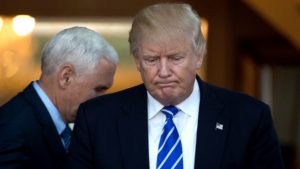Trump’s first 100 days – the fallout for US migration policy
To mark President Trump’s first 100 days in office, a leading migration think tank has issued a fact sheet that analyses the effect of major immigration actions taken by his administration.
The Washington-based Migration Policy Institute has looked at the sweeping set of actions on immigration taken by President Trump, ranging from imposing a travel ban to cutting refugee admissions, ‘extreme vetting’, and boosting immigration enforcement at the border and in inside the US.
It particularly looks at the five executive orders that give new instructions for immigration enforcement restricting entry of nationals from six majority-Muslim countries and the pausing of the US’ refugee resettlement program.
The fact sheet also examines related implementation memos from the Departments of Homeland Security and Justice, and traces developments in the courts and Congress. It also lists the executive-branch officials who have filled key immigration-related positions.
 A week after taking office President Trump signed an executive order suspending the entry of nationals from seven countries and stopping the US’ refugee resettlement program but the order was quickly became the subject of court challenges and its implementation was blocked, the fact sheet reveals.
A week after taking office President Trump signed an executive order suspending the entry of nationals from seven countries and stopping the US’ refugee resettlement program but the order was quickly became the subject of court challenges and its implementation was blocked, the fact sheet reveals.
It says that this resulted in a new narrower order that replaced and rescinded the first.
The second order restricted nationals of Iran, Libya, Somalia, Sudan, Syria and Yemen from entering unless they are lawful residents of the US, have a valid visa as of the January 27, 2017 or received a case-by-case waiver.
A third order requires relevant federal agencies to develop more rigorous screening procedures – or extreme vetting – for all new applicants for admission to the US.
But court challenges to the order have stopped the US Department of Homeland Security (DHS) from developing the procedures. However, the advent of the Trump administration appears to have dissuaded many people from attempting to enter the US.
Emirates, the Middle East’s largest airline, is cutting flights to the US by 20 per cent and tourism operators say 4.3 million fewer visitors will travel to the US this year, resulting in the loss of $7.4 billion in tourism revenue.
Yet another executive order directed the DHS to begin construction of a barrier along the south western border with Mexico and begin the recruitment of extra border at a cost of up to $5 billion.
One more executive order broadened the categories of non-citizens who can be deported leading to a 33 per cent increase in the removal of ‘non-citizens’.
The arrests of people without criminal records has more than doubled with 5,441 taken into custody.
Also, the US Attorney General Jeff Sessions has threatened to withhold Justice Department grants from states and cities which are so called ‘sanctuary cities’ offering refuge to non-citizens.
At least 33 states have either debated or enacted legislation precenting local jurisdictions from enacting policies that limit compliance with Immigration and Customs Enforcement, while others have done the opposite.
Draft legislation in California would prohibit state and local law enforcement from using resources for immigration enforcement without a judicial warrant.
See the fact sheet in full here: http://www.migrationpolicy.org/research/first-100-days-summary-major-immigration-actions-taken-trump-administration
Laurie Nowell
AMES Australia Staff Writer












